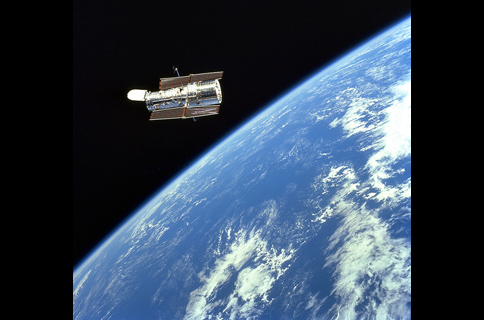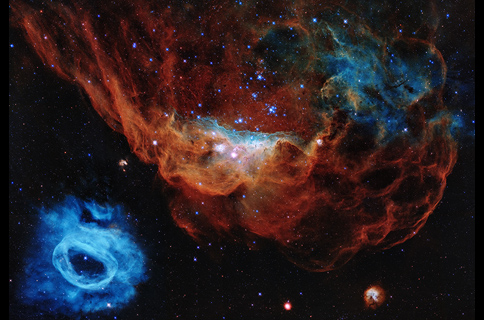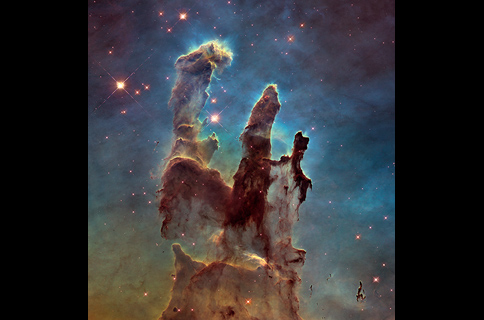- Home
- Exhibitions & Events
- FUJIFILM SQUARE Photo Exhibition The Hubble Space Telescope - celebrating 30 years of unraveling the mysteries of the universe
Finest selection of images of celestial bodies
FUJIFILM SQUARE Photo Exhibition
The Hubble Space Telescope
- celebrating 30 years of unraveling the mysteries of the universe
We are pleased to present the photo exhibition “The Hubble Space Telescope - celebrating 30 years of unraveling the mysteries of the universe” which will be held at the Fujifilm Photo Salon, FUJIFILM SQUARE from November 27 — December 17, 2020.
In 1990, the space shuttle Discovery launched the Hubble Space Telescope into space, and this year marks the 30th anniversary of this momentous achievement. The Hubble Space Telescope, a project of international cooperation between the National Aeronautics and Space Administration (NASA) and the European Space Agency (ESA), was launched into low Earth orbit and continues to observe comets and planets from an altitude of approx. 550 kilometers.
The Hubble Space Telescope is a reflecting telescope equipped with a 2.4 meter mirror which enables it to observe visible light and other wavelengths. It is the first telescope able to search meticulously through space for visible light, i.e. the same kind of light that is visible to the human eye. Also, in contrast to Earth-based telescopes, the Hubble Space Telescope is capable of observing the universe without being subject to the influence of atmospheric conditions, and is able to reflect finely-detailed images of nebulae and galaxies. The observational data relayed by the telescope provides astronomers with information to help them unravel the myriad mysteries of the universe. For the past 30 years, the telescope has also been depicting images of the beauty of the universe that delight and capture the imagination of non-specialist viewers, something that was previously unimaginable.
To mark the 30th anniversary of the launching of the Hubble Space Telescope, this exhibition features a number of carefully selected images that depict some of the most beautiful celestial bodies — from those that symbolize the Hubble telescope through to the very latest images.
The Hubble Space Telescope has been called one the most important scientific instruments in the history of humankind. We are commemorating the occasion of its 30th anniversary by presenting a variety of the remarkable celestial bodies captured by this ‘legacy of space exploration’ that have enthralled specialists and laymen alike in enlarged, high-quality, silver halide prints.
Images of celestial bodies
In the Milky Way galaxy in which we live, stars made up of gas and dust are born in the nebula. When the stars reach the end of their existence, emitted gases and dust from the stars form exquisitely beautiful nebulae. The high-definition images of those nebulae reflected by the Hubble Space Telescope are truly dazzling.
The Hubble Space Telescope is now also shifting its focus beyond the Milky Way. Hundreds of billions of galaxies exist in the universe, and each of them is in a different flux state. The Hubble is able to capture finely-detailed images of a diverse array of galaxies and even colliding galaxies, and depict vastly distant galaxies as vividly as though they were our near neighbors. Visitors to the exhibition will be rewarded with an uplifting feeling after viewing these wonders of the universe.
Profile of the Exhibition Supervisor, Junichi Watanabe

Vice Director General and Professor at the Astronomy Data Center, National Astronomical Observatory of Japan, and Professor at the Department of Astronomical Science, School of Mathematical and Physical Science, Graduate University for Advanced Studies. Born in Fukushima prefecture in 1960, he graduated from the Department of Astronomy, Faculty of Science, University of Tokyo in 1983, and completed a Ph.D. at the University of Tokyo in 1988. Present posts include Director of Public Relations and Director of Astronomical Data at the National Astronomical Observatory of Japan. Specializes in observation of small solar system bodies (comets, asteroids, meteors, etc.). Instrumental in the establishment of a new category for dwarf planets as a member of the Planet Definition Committee of the International Astronomical Union (IAU), which defined Pluto as a dwarf planet. Appointed as a Vice-President of the IAU in 2018.
Related events
To commemorate this exhibition, we are planning to invite Professor Junichi Watanabe, supervisor of the exhibition, to discuss the achievements of the Hubble Space Telescope and the images on display.
| Name of exhibition | FUJIFILM SQUARE Photo Exhibition The Hubble Space Telescope - celebrating 30 years of unraveling the mysteries of the universe |
|---|---|
| Dates and times |
November 27 — December 17, 2020 10:00 — 19:00 (Closes at 14:00 on final day of the exhibition, last entry is ten minutes before closing time) open everyday throughout the exhibition |
| Venue | Fujifilm Photo Salon, FUJIFILM SQUARE |
| Admission | Free * This exhibition is being held as a corporate MECENAT event, and we are pleased to announce that admission will be free to enable more visitors to attend the exhibition. |
| Organized by | FUJIFILM Corporation |
| Supervised by | Professor Junichi Watanabe, Vice Director General of the National Astronomical Observatory of Japan, Research Institute of Natural Sciences, Inter-University Research Institute Corporation National Institutes for the Humanities |
| Cooperation by | The National Astronomical Observatory of Japan, Research Institute of Natural Sciences, Inter-University Research Institute Corporation National Institutes for the Humanities |
| Exhibition planning by | Crevis Inc. |
| Planning cooperation by | Noriaki Okamoto, science writer |
* Please note that the exhibition and related events may be subject to change or cancelation due to unavoidable circumstances. Thank you for your kind understanding.
Related information
In 2018, the photo exhibition ‘13.8 billion light years — voyages to explore the mysteries of the universe’ was held at FUJIFILM SQUARE. Further additions have been made, and the exhibition is now on display at the Tokyo Photographic Art Museum.
| Name of exhibition | ‘13.8 billion light years — voyages to explore the mysteries of the universe’ |
|---|---|
| Dates and times | November 21, 2020 — January 24, 2021 10:00 — 18:00 (last entry is 30 minutes before closing) |
| Weekly closing day | Closed on Monday each week (However, will be open on Monday, November 23 and Monday, January 11, but will be closed instead on Tuesday ,November 24 and Tuesday, January 12). Please note that the exhibition will be closed throughout the year-end, new-year holidays (from December 29 to January 1) |
| Venue | Tokyo Photographic Art Museum, Exhibition room on basement first floor 1-13-3 Mita, Meguro-ku, Tokyo 153-0062 (inside the Yebisu Garden Place |
| Admission fees | General — 1000 yen; students — 800 yen; junior and senior high school students and over 65s — 600 yen |
| Inquiries to | Crevis Inc. Tel: 03-6427-2806 (Weekdays from 10:00 to 18:00) |

In 2020, the Fujifilm Photo Salon, Tokyo, was recognized by the Association for Corporate Support of the Arts for “contributions to society through the promotion of arts and culture” and has been authorized to use the “THIS IS MECENAT 2020” logo.







